intercricket manual - Ecb - England and Wales Cricket Board
intercricket manual - Ecb - England and Wales Cricket Board
intercricket manual - Ecb - England and Wales Cricket Board
You also want an ePaper? Increase the reach of your titles
YUMPU automatically turns print PDFs into web optimized ePapers that Google loves.
Introduction<br />
Introduction to Inter <strong>Cricket</strong><br />
Inter <strong>Cricket</strong> is a new format of the game, created by the <strong>Engl<strong>and</strong></strong> <strong>and</strong> <strong>Wales</strong> <strong>Cricket</strong> <strong>Board</strong>,<br />
to bridge the gap between Kwik <strong>Cricket</strong> <strong>and</strong> hardball cricket.<br />
Inter <strong>Cricket</strong> enables both boys <strong>and</strong> girls to learn about <strong>and</strong> experience the game of<br />
cricket, whether in the club, school or neighbourhood environment. The new rules <strong>and</strong><br />
specially designed equipment mean that the game can be played safely indoors <strong>and</strong><br />
outdoors, on almost any surface.<br />
Previous experience of Kwik <strong>Cricket</strong> may benefit some players but is certainly not<br />
essential.
Introduction<br />
NatWest <strong>and</strong> ECB’s Involvement in Inter <strong>Cricket</strong> <strong>and</strong> Young Players<br />
NatWest has supported cricket for 25 years <strong>and</strong> Inter <strong>Cricket</strong> is its first schools-based<br />
activity. This initiative seeks to significantly raise the profile of cricket in schools <strong>and</strong> clubs<br />
by introducing cricket to a new generation.<br />
ECB <strong>and</strong> NatWest are wholly committed to supporting Inter <strong>Cricket</strong> in schools <strong>and</strong> clubs<br />
<strong>and</strong> through Get Inter <strong>Cricket</strong> to enable teachers <strong>and</strong> coaches to teach Inter <strong>Cricket</strong><br />
with confidence <strong>and</strong> creativity. ECB has designed these resources as a tool for coaches to<br />
assist them in implementing effective <strong>and</strong> memorable Inter <strong>Cricket</strong> activities. They also aim<br />
to encourage clubs to foster student ability <strong>and</strong> interest so that players will want to further<br />
their participation by accessing the activities of the local cricket club. A complementary<br />
DVD <strong>and</strong> on-line resources have been designed to accompany this folder, <strong>and</strong> to provide<br />
additional ideas, whilst you may also wish to explore the ECB website for further<br />
information <strong>and</strong> support – www.ecb.co.uk/<strong>intercricket</strong>.
Introduction<br />
Introduction to the Resources<br />
What is Get Inter <strong>Cricket</strong><br />
Get Inter <strong>Cricket</strong> is a multi-media cricket resource that has been designed for use in<br />
secondary schools <strong>and</strong> cricket clubs to assist teachers <strong>and</strong> coaches in the planning <strong>and</strong><br />
delivery of cricket for the 11-14 age group. The resources have been developed in<br />
conjunction with experienced cricket experts <strong>and</strong> organisations <strong>and</strong> with practising<br />
teaching professionals in <strong>Engl<strong>and</strong></strong> <strong>and</strong> <strong>Wales</strong>. The entire Get Inter <strong>Cricket</strong> educational<br />
offering introduces an exciting way for players of all ages <strong>and</strong> abilities to develop their<br />
skills <strong>and</strong> progress toward the st<strong>and</strong>ard game.<br />
What does Get Inter <strong>Cricket</strong> offer<br />
This pack has been specifically designed to develop basic cricket skills for all players aged<br />
11-14. The resource encourages the development of these skills as well as playing in a<br />
team <strong>and</strong> with children of different ages <strong>and</strong> abilities.<br />
Get Inter <strong>Cricket</strong> has been created to motivate young players in every activity by<br />
encouraging the participation of everyone, regardless of ability, <strong>and</strong> shifting the focus to<br />
the improvement of personal performance rather than winning or losing. This encourages<br />
all players to try their best <strong>and</strong> to set personal goals to improve their own performances.
Introduction<br />
How to use this Resource<br />
The Get Inter <strong>Cricket</strong> resource comprises a ring-bound folder divided into sections,<br />
containing:<br />
1 x 37 page ‘loose-leaf’ <strong>manual</strong><br />
6 x A3 posters for the club – each of these demonstrates a core skill<br />
Manual Layout <strong>and</strong> Contents<br />
The <strong>manual</strong> is divided into four sections:<br />
1. Working with Young <strong>Cricket</strong>ers<br />
2. Playing Inter <strong>Cricket</strong><br />
3. Useful Information<br />
4. Additional Resources<br />
Working with Young <strong>Cricket</strong>ers<br />
Contains sections on:<br />
• maintaining young players' interest in cricket<br />
• the transition between late primary (<strong>and</strong> Kwik <strong>Cricket</strong>) <strong>and</strong> early secondary<br />
school ages (Inter <strong>Cricket</strong>)<br />
• guidelines for working with children <strong>and</strong> how to maximise inclusion,<br />
working with students with all levels of ability <strong>and</strong> need, <strong>and</strong> introducing various<br />
roles to ensure full participation by all students at all times<br />
• useful coaching tips<br />
• wet weather activities<br />
Playing Inter <strong>Cricket</strong><br />
This section covers playing Inter <strong>Cricket</strong> indoors <strong>and</strong> outdoors. It also contains<br />
suggestions for linking with schools, including running competitions.
Working with Young <strong>Cricket</strong>ers<br />
Maintaining Young Players’ Interest in <strong>Cricket</strong><br />
Children in the 11-14 age group are an incredibly varied group. Some will appear quite<br />
advanced <strong>and</strong> confident, others shy <strong>and</strong> unsure, others still may appear blasé <strong>and</strong><br />
uninterested. They will have already decided whether they are into sport or not, some of<br />
them will have well-developed skills <strong>and</strong> others will not.<br />
Enthusiasm for cricket will also vary a great deal (although presence at your club would<br />
suggest that they are keen cricketers). Some children may have played Kwik <strong>Cricket</strong>,<br />
others may have some experience of the st<strong>and</strong>ard game <strong>and</strong> others may have no<br />
experience of cricket whatsoever. Cultural backgrounds <strong>and</strong> home environments will also<br />
affect attitudes to the game.<br />
Inter <strong>Cricket</strong> was created with sufficient flexibility to meet the needs <strong>and</strong> fit the ability of all<br />
of these pupils. Because of its coloured kit <strong>and</strong> white ball, Inter <strong>Cricket</strong> has a ‘cooler’<br />
perceived appearance than traditional cricket. It is also very exciting <strong>and</strong> fast-paced,<br />
whilst being reassuringly safe.<br />
Inter <strong>Cricket</strong>, <strong>and</strong> cricket in general, will also gain credibility following the success of the<br />
2005 cricket season (final results unknown at time of writing but looking good!). You may<br />
experience an increased number of enquiries <strong>and</strong> visits to your club both immediately <strong>and</strong><br />
longer term following this significant time for English cricket, which has considerably raised<br />
the profile of the game.<br />
Progress players from Kwik <strong>Cricket</strong> through to Inter <strong>Cricket</strong> <strong>and</strong> on to the st<strong>and</strong>ard game<br />
as quickly as is appropriate – they will want to move on <strong>and</strong> develop their skills <strong>and</strong> may<br />
lose interest if they feel they are being held back.
Working with Young <strong>Cricket</strong>ers<br />
The Transition from Kwik <strong>Cricket</strong> to Inter <strong>Cricket</strong><br />
Some of the children playing at your club may have experience of Kwik <strong>Cricket</strong> (<strong>and</strong> may<br />
even have played it at your club). If you are not familiar with this format of the game, here<br />
is a brief summary:<br />
Kwik <strong>Cricket</strong> is a simple game designed specifically for all children between the ages of<br />
five <strong>and</strong> 11, <strong>and</strong> is the result of many years of detailed product development <strong>and</strong> research<br />
by the <strong>Engl<strong>and</strong></strong> <strong>and</strong> <strong>Wales</strong> <strong>Cricket</strong> <strong>Board</strong> in consultation with cricket coaches, <strong>Cricket</strong><br />
Development Officers, education authorities, teachers <strong>and</strong> children.<br />
The emphasis of Kwik <strong>Cricket</strong> is on participation <strong>and</strong> enjoyment. In practice, any number<br />
of children can play, from two to 32, as the game can be adapted to your own particular<br />
environment in terms of time available <strong>and</strong> numbers playing.<br />
Kwik <strong>Cricket</strong> equipment is made from high-quality moulded plastic. It is light enough for<br />
small h<strong>and</strong>s yet extremely tough <strong>and</strong> hard wearing. It has been designed as an alternative<br />
to traditional equipment to allow the game to be played safely on any flat surface, either<br />
indoors or outdoors. Kits include three different sizes of bat <strong>and</strong> a ‘batting tee’.<br />
Kwik <strong>Cricket</strong> can be played in a number of ways, including continuous cricket, pairs cricket<br />
or ‘Lord’s Game’.<br />
To find out more about Kwik <strong>Cricket</strong> <strong>and</strong> to order a kit, visit www.ecb.co.uk/kwikcricket.<br />
This game has been highly effective in motivating children to develop their cricket skills.<br />
Children attending your club who have played Kwik <strong>Cricket</strong> will be keen to progress to Inter<br />
<strong>Cricket</strong> <strong>and</strong> on to the st<strong>and</strong>ard game.
Working with Young <strong>Cricket</strong>ers<br />
Guidelines for Working with Children<br />
Good practice means<br />
• ensuring that cricket is fun, enjoyable <strong>and</strong> fair play is promoted.<br />
• treating all young people <strong>and</strong> disabled adults equally, with respect <strong>and</strong> dignity.<br />
• being an excellent role model – this includes not smoking or drinking alcohol while<br />
coaching young people.<br />
• always putting the welfare of young people first, before winning or achieving goals by<br />
encouraging a constructive environment where healthy competition, skill development,<br />
fun <strong>and</strong> achievement are promoted in equal measures.<br />
• always working in an open environment (e.g. avoiding being alone with a child, <strong>and</strong><br />
encouraging open communication with no secrets).<br />
• building balanced relationships based on trust which enable young people to take part<br />
in the decision-making process.<br />
• in line with Home Office guidelines, if you are in a position of trust <strong>and</strong> authority, you<br />
do not have sexual relationships with 16-17 year olds or vulnerable adults in your care.<br />
• not tolerating acts of aggression.<br />
• recognising the needs <strong>and</strong> abilities of young people, avoiding too much training or<br />
competition <strong>and</strong> not pushing them against their will.<br />
• giving enthusiastic <strong>and</strong> constructive feedback rather than negative criticism.<br />
• working to the ECB guidance on physical contact, where young people are always<br />
consulted <strong>and</strong> their agreement gained before any contact.<br />
• keeping up-to-date with technical skills, qualifications <strong>and</strong> insurance in sport.<br />
• making sure there are always at least two appropriate adults present if groups have to<br />
be supervised in the changing rooms.<br />
• ensuring that if mixed sex teams are taken away, they are always accompanied by a<br />
male <strong>and</strong> female member of staff.
Working with Young <strong>Cricket</strong>ers<br />
• while on tour, you do not enter a young person’s room or invite them into your room.<br />
• keeping a written record any time a young person is injured in your care, along with<br />
the details of any treatment provided.<br />
• promoting good sportsmanship by encouraging young people to be considerate of<br />
other athletes, officials <strong>and</strong> club volunteers <strong>and</strong> by being modest in victory <strong>and</strong><br />
gracious in defeat.<br />
• helping the ECB to work toward eradicating harassment <strong>and</strong> abuse of young people<br />
from cricket.<br />
Poor practice means you must never:<br />
• spend excessive amounts of time alone with children away from others.<br />
• take or drop off a child at an event.<br />
• take young people to your home or transport them by car, where they will be alone<br />
with you.<br />
• engage in rough, physical or sexually provocative games.<br />
• share a room with a young person.<br />
• allow or engage in any form of inappropriate touching or physical abuse.<br />
• take part in or tolerate behaviour that frightens, embarrasses or demoralises a<br />
cricketer or that harms their self esteem.<br />
• allow young people to use inappropriate language unchallenged.<br />
• make sexually suggestive comments to a child, even in fun.<br />
• make a young person cry as a form of control.<br />
• allow allegations made by a child to go unchallenged, unrecorded or ignored.<br />
• do things of a personal nature for young people or vulnerable adults that they can do<br />
for themselves.<br />
• shower with a young person..
Working with Young <strong>Cricket</strong>ers<br />
The following guidance is about protecting children who are learning to play cricket. It will<br />
also help to protect coaches from unnecessary or malicious allegations when working with<br />
children or young people.<br />
• If a child or young person becomes injured during a coaching session <strong>and</strong> the injury<br />
requires the child to be carried to a place of treatment, always seek support from<br />
another adult before moving the child or young person. Any first aid administered<br />
should be in the presence of another adult or in open view of others.<br />
• If the child or young person seems uncomfortable in any way with the physical<br />
contact, stop immediately.<br />
• If the child or young person you are working with is visually impaired, you should tell<br />
them who you are <strong>and</strong> ask their permission before you come into physical contact<br />
with them.<br />
• Never attempt to adjust the grip of a child or young person when in the normal<br />
batting stance position.
Working with Young <strong>Cricket</strong>ers<br />
• Never find yourself in a situation where you are the only adult present around children<br />
or young people, e.g. in changing rooms, showers, or on a minibus.<br />
• Where physical contact is for motivational or celebratory reasons, agree with the<br />
children, young people, teachers or other appropriate adults that to praise good<br />
performance a ‘High Five’ or similar action will be used.<br />
• Never help children dress, e.g. to put on pads, a protective box or clothing unless<br />
they request this <strong>and</strong> genuinely require assistance.<br />
• Never take on one to one coaching with a child or young person unless another adult<br />
or parent is present.<br />
• If you need to communicate with a child or young person for the purposes of<br />
coaching or passing on cricket information, use a parent’s mobile telephone number.<br />
If you have agreed with the parents in advance to use the child’s own mobile phone<br />
for communicating with them, under no circumstances make the number available for<br />
general circulation.<br />
For further information on the safe h<strong>and</strong>s policy, go to<br />
www.ecb.co.uk/safeh<strong>and</strong>s.
Working with Young <strong>Cricket</strong>ers<br />
Physical growth <strong>and</strong> development<br />
Differences in physical maturation will affect young players’ capability to develop cricket<br />
skills. These differences can be as much as four years within the same age group. Group<br />
coaching is ideally suited to organising children, differentiating by ability <strong>and</strong>/or physical<br />
maturation, rather than purely by age. Coaches should ensure that appropriate equipment<br />
is available for all individuals.<br />
When coaching young children, coaches need to be aware that:<br />
• Early maturers often perform impressively but may be ‘caught up’ <strong>and</strong> overtaken by<br />
late maturers during adolescence.<br />
• Early or late physical development may cause emotional problems.<br />
• Boys may begin a growth spurt as early as 12 or as late as 15 but generally peak at<br />
around 14.<br />
• Girls may begin their growth spurt earlier <strong>and</strong> usually peak around 12.<br />
• Boys normally reach their adult height at 17 or 18.<br />
• Girls usually reach their adult height by 15 or 16.
Working with Young <strong>Cricket</strong>ers<br />
Children <strong>and</strong> exercise<br />
An important part of helping young children cope with the physical dem<strong>and</strong>s of cricket is<br />
rest. Practices should allow sufficient rest periods after bursts of activity. Early morning or<br />
late evening sessions are not ideal for younger players as they may reduce resistance to<br />
fatigue.<br />
Coaches should note that:<br />
• Children breathe more often than adults <strong>and</strong> are therefore more prone to<br />
dehydration – drinks should be available at all times during sessions. Children<br />
should be encouraged to drink a ‘little <strong>and</strong> often’ when involved in physical activity.<br />
• Children are more susceptible to heat loss or gain <strong>and</strong> therefore should be<br />
appropriately dressed for the environment in which activity is taking place.<br />
• Intensive training during growth spurts can lead to injury.<br />
• Inappropriate forms of training that are based on adult principles will increase the<br />
risk of injury.<br />
Mental growth <strong>and</strong> development<br />
• Young players tend to look to coaches, teachers, parents <strong>and</strong> friends to find out<br />
more about the world <strong>and</strong> themselves.<br />
• It is important that coaches help children attain a positive self-image by being<br />
Positive, Encouraging <strong>and</strong> Supportive <strong>and</strong> encourage a positive perception<br />
of the cricket activities they are asked to undertake.<br />
• Broader issues such as physical development, transferable skill development,<br />
social development <strong>and</strong> the development of self confidence are all benefits of<br />
effective coaching.
Working with Young <strong>Cricket</strong>ers<br />
Useful Tips for Coaching Young Players<br />
This <strong>manual</strong> is designed for coaches (<strong>and</strong> potential coaches) of all levels, so some of the<br />
tips below may already be familiar to you. If not, we hope they will give you some<br />
encouraging advice on coaching young cricketers.<br />
Your coaching style<br />
Your role as a coach is to use all the resources available to ensure that your young<br />
cricketers have the opportunity to develop their skills <strong>and</strong> talents, whatever their particular<br />
abilities may be.<br />
With experience, you will develop your own personal coaching philosophy. The following<br />
questions will help you to begin to arrive at this ethos:<br />
• How important is winning to me<br />
• What is my attitude towards gamesmanship <strong>and</strong> cheating<br />
• Which is more important – the person or the technique<br />
• How would I be described by players I coach<br />
• How would my coaching colleagues describe me<br />
• What is my attitude towards my development as a coach<br />
• How often do I plan my sessions<br />
• Do I take a long-term view of developing players or am I focused more on shortterm<br />
success<br />
• How often do I evaluate my sessions<br />
• What do I enjoy most about coaching children<br />
• Do I provide a positive role model for young people<br />
• Are my practice sessions fun<br />
• What proportion of my feedback is critical<br />
• Do I tend to ask questions or provide answers<br />
• Am I prepared to explore new ideas
Working with Young <strong>Cricket</strong>ers<br />
All effective coaches will share the following skills:<br />
• Planning skills<br />
• Communication skills (this applies to listening as much as it does to speaking)<br />
• Motivational skills<br />
• Organisational <strong>and</strong> administrative skills<br />
• Analytical skills<br />
• Style that can be flexible according to individual needs<br />
Coaching young people<br />
Some useful pointers:<br />
• Young players tend to have relatively short attention spans – keep their interest.<br />
• Long drawn-out explanations <strong>and</strong>/or demonstrations may bore them – keep it brief<br />
<strong>and</strong> to the point.<br />
• Progress at the appropriate pace for the learner – individuals learn at different<br />
speeds.<br />
• Early activity brings enjoyment <strong>and</strong> maximum learning – activity is the key to<br />
holding interest.<br />
• Errors are a learning medium – everyone makes them <strong>and</strong> everyone can learn<br />
from them.
Working with Young <strong>Cricket</strong>ers<br />
Think long-term development rather than immediate short-term results.<br />
“It takes 10 years of extensive training to excel in anything”<br />
Herbert Simon, Nobel Laureate<br />
• All young performers display similar characteristics of physical, mental <strong>and</strong><br />
emotional growth <strong>and</strong> development. These characteristics can help the coach both<br />
underst<strong>and</strong> performance capabilities <strong>and</strong> limitations, <strong>and</strong> assist in the design of<br />
appropriate training, practice <strong>and</strong> play programmes.<br />
• <strong>Cricket</strong>, like almost all team <strong>and</strong> ball sports, is a late-specialisation sport. All young<br />
performers should be encouraged to participate in as many other sports as<br />
possible from an early age, in order to acquire all-round athleticism <strong>and</strong> as a means<br />
of helping improve their cricket skills.<br />
• Young performers are not simply “little adults”. All programmes designed for young<br />
players should be carefully considered to take into account growth <strong>and</strong><br />
development issues.<br />
• A balanced ‘play : practice : rest’ ratio is essential for optimum performance.<br />
Teaching new skills<br />
When teaching a new skill or enhancing an existing one, the IDEAL sequence may be<br />
useful:<br />
I<br />
D<br />
E<br />
A<br />
L<br />
Introduce the skill.<br />
Demonstrate or provide an appropriate ‘technical model’.<br />
Explain the key technical <strong>and</strong> organisational points.<br />
Activity as individuals or groups practice.<br />
Learning through further activity, demonstrations, explanations, <strong>and</strong> positive <strong>and</strong><br />
corrective feedback.
Working with Young <strong>Cricket</strong>ers<br />
Underst<strong>and</strong>ing how players learn<br />
Complex skills are often better understood when explained in smaller, more manageable<br />
parts. A ‘drip-feed’ approach is recommended in which coaching points, supported by an<br />
appropriate technical model, are followed quickly by group activity. Coaches should move<br />
from simple to more complex, <strong>and</strong> from closed skill to more open skill activities appropriate<br />
to the performer’s skill development.<br />
Shaping <strong>and</strong> chaining are two methods which are particularly useful when either<br />
introducing new skills or modifying existing techniques.<br />
Shaping involves attempting the ‘whole’ movement <strong>and</strong> gradually refining it. This approach<br />
is often used when introducing batting skills during group coaching.<br />
Chaining is dismantling the technique into its component parts, allowing players to work<br />
progressively through each. Chaining may be either sequenced from the starting position<br />
of the skill, or from the point of impact or release backwards. This latter method is known<br />
as reverse chaining.<br />
Setting goals<br />
Motivating players can be achieved with goal setting. By focusing on process <strong>and</strong><br />
performance goals (what the player needs to do), rather than outcome goals (the results of<br />
a game or session), coaches can contribute towards players’ motivation <strong>and</strong> confidence<br />
levels. When setting goals, use the ‘Smarter’ approach.<br />
Goals should be:<br />
S<br />
M<br />
A<br />
R<br />
T<br />
E<br />
R<br />
Specific to the programme<br />
Measurable<br />
Agreed <strong>and</strong> accepted by the player<br />
Realistic, but challenging<br />
Time phased – set against a time frame<br />
Exciting – sufficiently challenging to allow a sense of achievement on attainment<br />
Recorded – to allow coaches <strong>and</strong> players to monitor progress
Working with Young <strong>Cricket</strong>ers<br />
General advice for coaching staff<br />
• Be punctual <strong>and</strong> look the part - create the right image. Be enthusiastic!<br />
• Prepare coaching sessions thoroughly.<br />
• Coaching sessions should be enjoyable, realistic <strong>and</strong> fun.<br />
• Ensure maximum activity at all times.<br />
• Make allowances for different ages <strong>and</strong> abilities. Be patient <strong>and</strong> sympathetic.<br />
• Report any serious injuries to the organiser(s) immediately.<br />
• Equipment should be checked at the start <strong>and</strong> finish of each session. Any loss of<br />
equipment should be reported to the organiser(s) as soon as possible.<br />
• Closing remarks should include encouragement to practice at every opportunity.<br />
• Wherever possible, stress the importance of playing the game in the correct spirit,<br />
<strong>and</strong> respecting the opponents <strong>and</strong> officials on <strong>and</strong> off the field.<br />
Words of Wisdom!<br />
• Failing to prepare is preparing to fail.<br />
• An ounce of theory to a ton of practice.<br />
• Do not talk a demonstration. A picture paints a thous<strong>and</strong> words.<br />
• Coach the cause, not the result.<br />
• Coaching is serious fun.<br />
• Practice makes permanent. Permanently good or bad.<br />
For further information on cricket coaching, visit www.ecb.co.uk/ecb/coaching.<br />
Wet Weather Activities<br />
The weather does not mean that you have to give up on the day’s Inter <strong>Cricket</strong> training<br />
session. If the sports hall, cricket field or practice facility is already taken then you can<br />
always use the cricket pavilion, changing room or any other suitable indoor area available<br />
to engage with your young cricketers. Here are some ideas that will keep students learning<br />
the fun way.
Activity 1<br />
The Ten Ways of Being Out in <strong>Cricket</strong><br />
Match the correct definition with each of the ten ways to be out in cricket.<br />
Caught<br />
Bowled<br />
Leg Before Wicket<br />
Stumped<br />
Run Out<br />
Hit Wicket<br />
H<strong>and</strong>le the Ball<br />
Obstructing the Field<br />
Hit the Ball Twice<br />
Timed Out<br />
A<br />
B<br />
C<br />
D<br />
E<br />
F<br />
G<br />
H<br />
I<br />
J<br />
If a batsman hits a delivery with his bat <strong>and</strong> then deliberately hits the ball again for any reason other than to defend his wicket<br />
from being broken by the ball.<br />
If, in attempting to hit a ball or taking off for a first run, the batsman touches <strong>and</strong> breaks the wicket, he is out.<br />
If the batsman misses the ball <strong>and</strong> it hits <strong>and</strong> breaks the wicket directly from the bowler’s delivery. He is also out if the ball breaks<br />
the wicket after deflecting from his bat or body.<br />
If a new batsman takes longer than two minutes, from the time the previous wicket falls, to appear on the field.<br />
If a fielder catches the ball on the full after the batsman has hit it with his bat, or it has touched the h<strong>and</strong> holding the bat.<br />
If a batsman touches the ball with a h<strong>and</strong> not currently holding the bat, without the permission of the fielding side.<br />
If the ball hits the batsman without first hitting the bat, but would have hit the wicket if the batsman was not there, <strong>and</strong> the ball<br />
does not pitch on the leg side of the wicket the batsman will be out. However, if the ball strikes the batsman outside the line of<br />
the off-stump, <strong>and</strong> the batsman was attempting to play a stroke, he is not out.<br />
If either batsman is attempting to take a run, or to return to his crease after an aborted run, <strong>and</strong> a fielder breaks that batsman’s<br />
wicket with the ball while he is out of the crease.<br />
If a batsman deliberately interferes with the efforts of fielders to gather or catch the ball or affect a run out.<br />
If a batsman misses the ball <strong>and</strong> in attempting to play it steps outside his crease, he is out if the wicket-keeper gathers the ball<br />
<strong>and</strong> breaks the wicket with it before the batsman can ground part of his body or his bat behind his crease.<br />
What are the 5 most common ways of being out in cricket<br />
1. Way of being out ………………………………<br />
2. Way of being out ……………………………….<br />
3. Way of being out ………………………………<br />
4. Way of being out ……………………………….<br />
5. Way of being out ……………………………….
Activity 2<br />
<strong>Cricket</strong> Glossary<br />
Can you fill in the blanks <strong>and</strong> complete the glossary of cricket terms<br />
B _ _ _<br />
B _ _ _ _ _ _ _<br />
C _ _ _ _ B _ _ _ _ _<br />
C _ _ _ _ _<br />
H _ _ W _ _ _ _ _<br />
I _ _ _ _ _ _<br />
L _ _ B _ _ _ _ _ W _ _ _ _ _<br />
N _ B _ _ _<br />
N _ _ S _ _ _ _ _ _<br />
O _ _ _<br />
R _ _<br />
R _ _ O _ _<br />
One of the wooden crosspieces that sits on top of<br />
adjacent pairs of stumps to form a wicket.<br />
The perimeter of a cricket field, marked by an obvious<br />
fence or marker.<br />
When a batter is beaten by a ball <strong>and</strong> subsequently<br />
dismissed through the stumps being broken.<br />
One of the white lines marked on the pitch to denote<br />
different areas of play; either the bowling, popping, or<br />
return c _ _ _ _ _<br />
To strike <strong>and</strong> subsequently break the stumps with the bat<br />
resulting in the batter’s dismissal.<br />
The period of time spent batting by a team or individual.<br />
If the ball hits the batsman without first hitting the bat, but<br />
would have hit the wicket if the batsman was not there,<br />
<strong>and</strong> the ball does not pitch on the leg side of the wicket<br />
the batsman will be out. However, if the ball strikes the<br />
batsman outside the line of the off-stump, <strong>and</strong> the<br />
batsman was attempting to play a stroke, he is not out.<br />
An unfair bowl because (a) it rolled along the ground (b)<br />
the bowler threw the ball instead of bowling with a straight<br />
arm (c) the bowler overstepped the popping crease.<br />
A term used to describe the batter waiting at the<br />
bowler’s end.<br />
6 fair deliveries completes one of these.<br />
The method of scoring during a game of cricket. Also a<br />
single unit of score.<br />
A method of dismissing the batter by disturbing the<br />
stumps before the batter has made his ground <strong>and</strong> is<br />
within the batting crease.
Activity 2<br />
S _ _ _ _ _ _<br />
S _ _ _ _ _<br />
T _ _ _<br />
W _ _ _ _ _<br />
W _ _ _ _ _ M _ _ _ _ _<br />
W _ _ _ _ _ K _ _ _ _ _<br />
W _ _ _<br />
The name given to the batter who is facing the bowler. The<br />
batter is said to be “on strike”.<br />
Wooden uprights of which there are three on which the<br />
bails are balanced to form the wicket.<br />
A cricket match of International st<strong>and</strong>ard scheduled to last<br />
for 5 days.<br />
The collective term for 3 stumps <strong>and</strong> 2 bails at either end<br />
of the pitch.<br />
An over in which the bowler has taken a wicket without a<br />
batter scoring runs.<br />
Player who wears fielding gloves <strong>and</strong> st<strong>and</strong>s behind the<br />
batter’s wicket ready to catch the ball if the batter<br />
misses it.<br />
A ball that a batter cannot reach.
Activity 3<br />
<strong>Cricket</strong> Language – Word Search<br />
There are 16 words that are used in cricket, hidden in the puzzle. Can you find them <strong>and</strong><br />
list them all<br />
Words can be found in the following directions: upwards, downwards, diagonally <strong>and</strong> even<br />
backwards!<br />
1._________________<br />
2._________________<br />
3._________________<br />
4._________________<br />
5._________________<br />
6._________________<br />
7._________________<br />
8._________________<br />
9.__________________<br />
10._________________<br />
11._________________<br />
12._________________<br />
13._________________<br />
14._________________<br />
15._________________<br />
16._________________<br />
Now can you define what each word means in terms of cricket
Activity 4<br />
Healthy & Balanced Diet<br />
A healthy <strong>and</strong> balanced diet is essential as it provides the energy <strong>and</strong> nourishment<br />
everyone needs to be fit <strong>and</strong> active. All foods fit into one of the groups below <strong>and</strong> we need<br />
to eat more of some foods than others to have a healthy diet.<br />
What food does this group include<br />
How much do we<br />
need<br />
What do they provide<br />
Fruit &<br />
Vegetables<br />
All vegetables, raw, cooked, frozen <strong>and</strong><br />
canned<br />
All fruits, raw, cooked, frozen <strong>and</strong><br />
canned<br />
We should try to eat at<br />
least five portions of<br />
fruit <strong>and</strong> vegetables a<br />
day<br />
• Some forms of sugar, a type of<br />
carbohydrate<br />
• Vitamins such as vitamin C, carotenes<br />
(a type of vitamin A), folic acid<br />
• Fibre to help the intestines work well<br />
• Useful amounts of some minerals, like<br />
iron, potassium <strong>and</strong> calcium<br />
Bread, other<br />
cereals <strong>and</strong><br />
potatoes<br />
Bread, rolls, pizza base, chapattis,<br />
breakfast cereals, oats, pasta, rice,<br />
noodles, potatoes, yams, plantain,<br />
maize, millet <strong>and</strong> cornmeal <strong>and</strong> green<br />
bananas<br />
These are known as<br />
starchy foods <strong>and</strong> we<br />
need to make these the<br />
main part of our meals<br />
• Starch is a type of carbohydrate that<br />
the body uses for energy<br />
• Foods contain calcium, fibre, iron <strong>and</strong><br />
B vitamins<br />
• Many breakfast cereals <strong>and</strong> breads<br />
have added vitamins<br />
• Wholemeal <strong>and</strong> wholegrain versions<br />
provide plenty of fibre<br />
Milk <strong>and</strong><br />
dairy<br />
products<br />
Milk – full cream, semi-skimmed <strong>and</strong><br />
skimmed, cheese, yoghurt, fromage<br />
frais<br />
We need to eat<br />
moderate amounts of<br />
these foods everyday. It<br />
is a good choice to have<br />
the lower fat versions of<br />
these foods whenever<br />
possible<br />
• Protein which is needed for growth<br />
<strong>and</strong> repairing the body<br />
• Vitamins such as B12 <strong>and</strong> riboflavin,<br />
also vitamins A <strong>and</strong> D<br />
• Calcium to build <strong>and</strong> maintain healthy<br />
bones<br />
Foods<br />
containing<br />
fat; foods<br />
containing<br />
sugar<br />
Fat – butter, margarines, low-fat<br />
spreads, olive oil, sunflower oil <strong>and</strong><br />
other cooking oils, mayonnaise <strong>and</strong><br />
salad dressings<br />
Sugar – ice-cream, pastries, puddings,<br />
chocolate, sweets, biscuits, cakes,<br />
crisps <strong>and</strong> sugary drinks<br />
There is no need to cut<br />
these foods out<br />
completely, but make<br />
sure you get the balance<br />
right. Try not to eat<br />
these foods too often<br />
<strong>and</strong> keep them to small<br />
amounts. Enjoy them as<br />
treats<br />
• Fat which gives us energy <strong>and</strong> also fat<br />
soluble vitamins A, D, E <strong>and</strong> K<br />
• Essential fatty acids<br />
• Sugars<br />
Meat <strong>and</strong> fish<br />
alternatives<br />
Meat – beef, pork, bacon, lamb<br />
Meat products - sausages <strong>and</strong><br />
beefburgers<br />
Poultry – chicken, turkey<br />
Fish – fresh, frozen <strong>and</strong> canned<br />
Fish products – fish fingers <strong>and</strong> fish<br />
cakes<br />
Liver <strong>and</strong> kidney<br />
Non meat alternatives<br />
Eggs, nuts, beans <strong>and</strong> lentils (including<br />
baked beans, chickpeas, red <strong>and</strong><br />
green lentils), textured vegetable<br />
protein, soya mince<br />
We need to eat a variety<br />
of these foods in<br />
moderate amounts. It is<br />
a good choice to have<br />
the low fat versions<br />
whenever possible<br />
• Protein<br />
• B Vitamins like B12<br />
• Minerals like iron, zinc <strong>and</strong> magnesium<br />
*Source: www.lifebytes.gov.uk<br />
Create a 7 day healthy eating plan for your favourite cricket player including 3 meals <strong>and</strong><br />
two healthy snacks everyday.
Activity Answers<br />
Activity 1<br />
What are the 5 most common ways of being out in cricket<br />
• Caught<br />
• Stumped<br />
• Bowled<br />
• Run Out<br />
• Leg before Wicket<br />
Activity 2<br />
<strong>Cricket</strong> Glossary<br />
Bail, Boundary, Clean Bowled, Crease, Hit Wicket, Innings, Leg Before Wicket, No Ball, Non<br />
Striker, Over, Run, Run Out, Striker, Stumps, Test, Wicket, Wicket Maiden, Wicket Keeper,<br />
Wide<br />
Activity 3<br />
Word Search<br />
Bail, Boundary, Crease, Innings, Over, Test, Wicket, Maiden, Wide, Pitch, Bowled, Stumped,<br />
Drive, Backswing, Block, Caught<br />
Activity 4<br />
Students just need to demonstrate an underst<strong>and</strong>ing of a balanced <strong>and</strong> healthy diet.<br />
A variety of options available.
Playing Inter <strong>Cricket</strong><br />
Inter <strong>Cricket</strong> Equipment<br />
The Inter <strong>Cricket</strong> Set includes:<br />
• 3 pairs of ambidextrous batting gloves<br />
• 3 pairs of quick-change leg guards<br />
• 1 thread-stitched <strong>and</strong> 5 rubberised balls for indoor <strong>and</strong> outdoor use<br />
• 2 colourful sets of stumps<br />
• 1 pair of close-fitting wicket keeping gloves<br />
• 3 lightweight wooden cricket bats<br />
• All equipment comes in an Inter <strong>Cricket</strong> holdall<br />
To order equipment <strong>and</strong> for further information on Inter <strong>Cricket</strong>, visit<br />
www.ecb.co.uk/<strong>intercricket</strong> or call the ECB Development Information<br />
Line on 0800 214 314.<br />
However, this kit is not essential for playing Inter <strong>Cricket</strong>. St<strong>and</strong>ard (or modified) bats,<br />
gloves, leg guards <strong>and</strong> stumps can be used, along with any soft ball.
Playing Inter <strong>Cricket</strong><br />
Inter <strong>Cricket</strong> Indoors <strong>and</strong> Outdoors<br />
Inter <strong>Cricket</strong> can be easily adapted for play indoors or outdoors, so bad weather or limited<br />
facilities need not limit planned lessons or activities.<br />
The main differences in the indoor <strong>and</strong> outdoor game are set out in this section.<br />
Playing Inter <strong>Cricket</strong> Indoors<br />
Pitch<br />
• As set out in the diagram below, with permissible adjustments for local<br />
circumstances.<br />
• The pitch should be offset towards the striker’s end to offer a longer boundary to<br />
the boundary wall behind the bowler.<br />
• Pitch length may be adjusted to suit ball type <strong>and</strong> size of playing area.<br />
• The ‘running crease’ drawn across the pitch 15 yards (13.71m) from the middle<br />
stump at the strikers end may be reduced to a minimum of 10 yards. The shorter<br />
distance is set to encourage batters to run.<br />
Recommended length of pitch:<br />
• U12 = 20 yards (18.3m)<br />
• U13 = 21 yards (19.2m)<br />
Boundary<br />
• Over 14 = 22 yards (20.1m)<br />
Inner Zone<br />
Zone Score =+1<br />
15 yards<br />
4 feet<br />
Zone Score =+1<br />
Batter<br />
Running Crease<br />
Non-striker<br />
Zone Score =+1<br />
Bowler<br />
4 feet<br />
Boundary Score =+4 or +6
Playing Inter <strong>Cricket</strong><br />
Teams<br />
Each team has a minimum of six players, including a wicket keeper who does not bowl.<br />
Team size may be increased if space permits.<br />
A captain is appointed in each team. The captain, in consultation with team mates, is<br />
responsible for field placements <strong>and</strong> order of batting. Waiting batters act as scorers <strong>and</strong><br />
umpires.<br />
Batting<br />
Each team has one innings. An innings is closed after<br />
an agreed number of overs or when all batters are out.<br />
Normal cricket rules apply, except:<br />
• Non-striking batter waits level with <strong>and</strong> to the<br />
side of the ‘running crease’ <strong>and</strong> may not<br />
interfere with any bowled ball.<br />
• Batters change ends at the end of each over.<br />
• Batters may be caught out off the ceiling <strong>and</strong><br />
walls (except the boundary wall), providing the<br />
ball has not touched the floor.<br />
• To run-out a batter running to the ‘running<br />
crease’, the wicket has to be broken at the end<br />
the batter is running toward.<br />
• LBW may only be given if a batter deliberately blocks the ball to prevent it hitting<br />
the wicket.<br />
• A single remaining batter may continue batting, changing ends as necessary to<br />
receive strike.<br />
• A partner must run with the remaining batter; the whole side is out when the solo<br />
batter is out or either player is run out.<br />
• A batter retires on 15 but the last scoring hit counts (ie. if batter is on 14 <strong>and</strong> scores<br />
6 on their next hit, they retire on 20).<br />
• A retired batter may resume their innings when only one batter remains.
Playing Inter <strong>Cricket</strong><br />
Fielding<br />
• Captain tells fielders where to position. With the<br />
exception of the wicket keeper, no fielder is<br />
allowed to st<strong>and</strong> within 10 yards of the striking<br />
batter until the ball is played.<br />
Bowling<br />
• Bowl from one end only (overarm bowling). Only<br />
six balls to be bowled in any over.<br />
• If preferred, two bowlers may bowl in t<strong>and</strong>em,<br />
bowling alternately to complete either a six ball<br />
over or 2 x six ball overs. The inactive bowler<br />
may not field. No bowler may bowl more than<br />
four overs per session.<br />
• The ball which follows a no-ball or wide is a free<br />
hit (striker cannot be out on that hit).
Playing Inter <strong>Cricket</strong><br />
Scoring<br />
Batting team<br />
• Batters may run on any ball whether it is hit or not.<br />
• Batters score runs by running between the striker’s popping crease <strong>and</strong> the<br />
‘running crease’ (score 1 for each completed run).<br />
Zone score<br />
• 1 run is added to the batter’s score if a struck ball hits any wall other than the<br />
boundary wall behind the bowler.<br />
Boundaries<br />
Extras<br />
• 4 runs are added to the batter’s score if a struck ball hits the floor <strong>and</strong> then the<br />
boundary wall behind the bowler without touching any other wall beforeh<strong>and</strong>.<br />
• 6 runs are added to the batter’s score if a struck ball hits the boundary wall behind<br />
the bowler without touching the floor or any other wall beforeh<strong>and</strong>.<br />
• Add 2 runs to the team score for each no-ball or wide bowled by the opposing<br />
team (any completed runs, zone scores or boundaries are also added to the team<br />
score).<br />
• If the ‘free hit’ (immediately following a wide or no-ball) is also a wide or no-ball that<br />
ball is pronounced ‘dead’ <strong>and</strong> 6 runs are added to the team score.<br />
Explanatory note<br />
If a no-ball or wide is bowled immediately after a ‘free hit’ then 2 extra runs are scored, as<br />
described above. The following ball would then be a ‘free hit’, unless six balls have already<br />
been bowled in which case the over is ended <strong>and</strong> an additional 6 runs are added to the<br />
team score.
Playing Inter <strong>Cricket</strong><br />
Playing Inter <strong>Cricket</strong> Outdoors<br />
Pitch<br />
<br />
• As set out in the diagram, with permissible<br />
adjustments for local circumstances.<br />
Recommended length of pitch:<br />
• U12 = 20 yards (18.3m)<br />
• U13 = 21 yards (19.2m)<br />
• Over 14 = 22 yards (20.1m)<br />
<br />
<br />
<br />
<br />
<br />
<br />
• Pitch length may be adjusted to suit ball<br />
type <strong>and</strong> size of playing area.<br />
Teams<br />
<br />
<br />
Each team has a minimum of eight players, including a wicket keeper who does not bowl.<br />
A captain is appointed in each team. The captain, in consultation with team mates, is<br />
responsible for field placements <strong>and</strong> order of batting. Waiting batters can act as scorers<br />
<strong>and</strong> umpires.<br />
Boundary scores are as in the laws of cricket, ie. 4 or 6 runs. The zone score is ignored if<br />
the ball crosses the boundary.
Playing Inter <strong>Cricket</strong><br />
Batting<br />
Normal cricket rules apply, except:<br />
• 50% of team bat in the first innings <strong>and</strong> the remaining 50% in the second innings.<br />
• An innings is closed when an agreed number of overs has been bowled or when all<br />
batters are out.<br />
• A single remaining batter may continue batting, changing end as necessary to<br />
receive strike; a partner must run with the remaining batter; either batter may be<br />
run out to end the innings.<br />
• LBW may only be given if a batter deliberately blocks the ball to prevent it hitting<br />
the wicket.<br />
• A batter retires on 15 but the last scoring hit counts (ie. if batter is on 14 <strong>and</strong> scores<br />
6 on their next hit, they retire on 20).<br />
• A retired batter may resume their innings when only one batter remains.<br />
Fielding<br />
• Fielders, except for the wicket keeper <strong>and</strong> bowler, must start outside the inner zone<br />
<strong>and</strong> may only enter that zone as the batter hits the ball or the ball passes the batter.<br />
• The captain tells fielders where to place their fielding disc. Each fielder must<br />
position their disc to look over it toward the batter <strong>and</strong> then walk over it as the<br />
bowler bowls.<br />
• Fielders take their fielding disc to a new fielding position at the end of an over.<br />
• If a fielder attempts a run out <strong>and</strong> the ball hits the stumps, that ball is declared<br />
‘dead’ <strong>and</strong> no further runs may be scored.<br />
Bowling<br />
• Bowlers use their fielding disc to mark their run-up. Bowl (overarm) from both<br />
ends.<br />
• Minimum of eight overs per side per match. At least 50% of the team must bowl.<br />
• No bowler may bowl more than four overs. Only six balls to be bowled in any over.<br />
• The ball which follows a no-ball or wide is a ‘free hit’ (striker cannot be out on that<br />
hit). Name <strong>and</strong> signal of ‘free hit’ to be determined.
Playing Inter <strong>Cricket</strong><br />
Scoring<br />
Batting team<br />
Batters may run on any ball whether it is hit or not. St<strong>and</strong>ard cricket scoring applies,<br />
except:<br />
• Add 1 run (zone score) to the batter’s score if a ball is hit outside the inner zone but<br />
does not cross the boundary line.<br />
• Add 2 extra runs to the team score for each no-ball or wide bowled by the<br />
opposing team (any completed runs, zone scores or boundaries are also added to<br />
the team score).<br />
• If the free hit immediately following a wide or no-ball is also a wide or no-ball then<br />
that ball is pronounced ‘dead’ <strong>and</strong> 6 runs are added to the team score.<br />
Fielding team<br />
3 runs are scored each time a batter is out.<br />
Result: the team with the highest combined batting <strong>and</strong> fielding score wins. A tied game is<br />
acceptable. If a winner must be determined, use a bowl-out competition as follows:<br />
• Three bowlers from each team bowl one ball alternately at three stumps.<br />
• The ball may be a full toss or bounce once only.<br />
• The team scoring the most hits after that sequence is declared the winner.<br />
• If the scores are still tied after three balls per team then ‘sudden death’ applies.<br />
Explanatory note<br />
If a no-ball or wide is bowled immediately after a ‘free hit’, then 2 extra runs are scored, as<br />
described above. The following ball would then be a ‘free hit’ unless six balls have already<br />
been bowled, in which case the over is ended <strong>and</strong> an additional 6 runs are added to the<br />
team score.
Playing Inter <strong>Cricket</strong><br />
Training Drills <strong>and</strong> Exercises<br />
For a comprehensive range of training suggestions, see the ECB Coaches Manual.<br />
Suggestions for Creating Partnerships with Schools<br />
An increasing number of clubs already have good links with local schools. If yours does<br />
not, or you would like to improve existing links, the following suggestions may be useful.<br />
Clubs could appoint an individual to liaise with local schools. They could go <strong>and</strong> visit<br />
either Heads of PE or Head Teachers, on behalf of the club, <strong>and</strong> discuss ways of working<br />
together. Once relationships are established, regular mailshots could be used to inform<br />
schools of special events <strong>and</strong> regular training sessions.<br />
Some clubs run regular Inter <strong>Cricket</strong> sessions which local schools are invited to. Saturday<br />
mornings are a popular time.<br />
Your club could hold Inter <strong>Cricket</strong> festivals during spring <strong>and</strong> summer <strong>and</strong> invite local<br />
schools to enter teams. These could take place on school days, either after school or an<br />
hour or so before school finishes. ‘Round robin’ Inter <strong>Cricket</strong> competitions could be open<br />
to teams of different ages.<br />
A great way of demonstrating what your club can offer is to send qualified coaches (with all<br />
required qualifications <strong>and</strong> training) into schools to teach Inter <strong>Cricket</strong> during summer term.<br />
For further information on this initiative, you can get in touch with Edward Leverton, ECB<br />
National Development Manager for Education on 01752 307024 or alternatively email him<br />
on edward.leverton@ecb.co.uk.<br />
Keep children attending the club satisfied with regular training sessions during the week.<br />
These should meet all levels of ability. Make the sessions flexible <strong>and</strong> fun, <strong>and</strong> keep<br />
players busy with lots of challenging activities.
Useful Information<br />
Focus Clubs<br />
Your club has been identified by the ECB’s Community <strong>Cricket</strong> programme to act as the<br />
strategic lead, focus <strong>and</strong> profile for cricket on a local basis.<br />
In line with your Focus Club status, your club is required to offer innovative, well managed<br />
<strong>and</strong> wide reaching junior development on high quality facilities, in a safe, effective <strong>and</strong><br />
child-friendly environment as part of the Clubmark (club accreditation) process.<br />
Making contact with other Focus Clubs can be a useful way to develop new ideas, share<br />
experiences <strong>and</strong> run joint programmes <strong>and</strong> competitions.<br />
To get in touch with other Focus Clubs, contact the relevant <strong>Cricket</strong> Development Officer.
Useful Information<br />
<strong>Cricket</strong> Development Officers<br />
Development<br />
The ECB Development Department has overall responsibility for developing cricket activity<br />
in schools <strong>and</strong> clubs in <strong>Engl<strong>and</strong></strong> <strong>and</strong> <strong>Wales</strong>.<br />
The <strong>Cricket</strong> Development Officers (CDOs) <strong>and</strong> their County <strong>Board</strong>s are the mechanism to<br />
deliver these initiatives.<br />
Primary <strong>and</strong> secondary schools, clubs, district cricket <strong>and</strong> facilities are all crucial elements<br />
of a framework to provide children with the opportunity to experience the game, as well as<br />
a pathway for the more talented.<br />
Numerous activities <strong>and</strong> resources have been developed, or are being developed, for boys,<br />
girls, players with disabilities, teachers <strong>and</strong> coaches.<br />
Development Initiatives<br />
The ECB Development Department’s innovation <strong>and</strong> enterprise in launching new initiatives<br />
is paying dividends in reversing the decline in the numbers of school children playing<br />
cricket in <strong>Engl<strong>and</strong></strong> <strong>and</strong> <strong>Wales</strong>.
Useful Information<br />
Contact us<br />
If you have any development queries you should contact your local <strong>Cricket</strong> Development<br />
Officer - or email schools@ecb.co.uk for primary <strong>and</strong> secondary enquiries.<br />
You can also call the ECB’s Development Information Line on 0800 214 314.<br />
Sport <strong>Engl<strong>and</strong></strong><br />
You can also find a library of resources <strong>and</strong> information on the Sport <strong>Engl<strong>and</strong></strong> website -<br />
www.sportengl<strong>and</strong>.org.<br />
<strong>Cricket</strong> Development Officers<br />
<strong>Cricket</strong> in <strong>Engl<strong>and</strong></strong> <strong>and</strong> <strong>Wales</strong> has a nationwide development network, set up to administer<br />
the growth of the game. The various development staff are available to provide help <strong>and</strong><br />
advice to you on all aspects of cricket.<br />
To find the contact details of your local <strong>Cricket</strong> Development Officer, go to<br />
www.ecb.uk.uk/ecb/development.


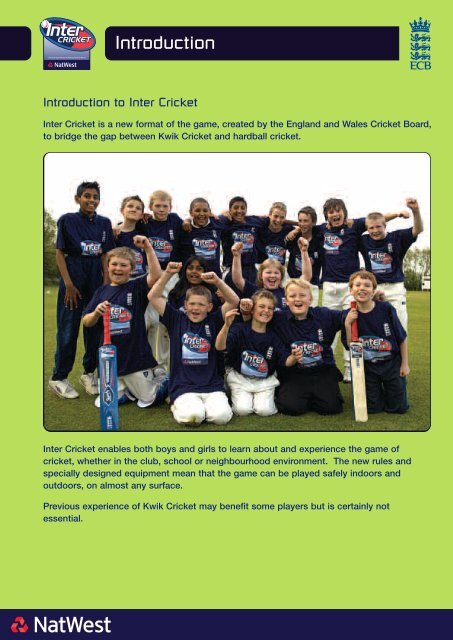
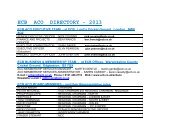

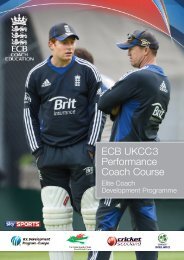

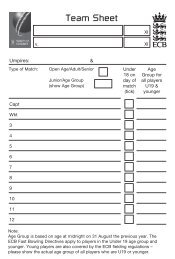
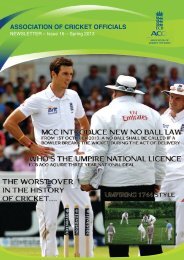
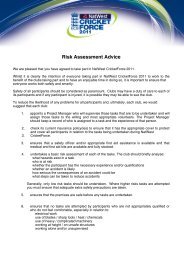
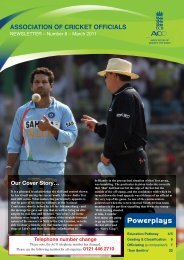


![Indoor Sports Halls with Cricket Provision [TS3] - Ecb - England and ...](https://img.yumpu.com/49070696/1/190x135/indoor-sports-halls-with-cricket-provision-ts3-ecb-england-and-.jpg?quality=85)



